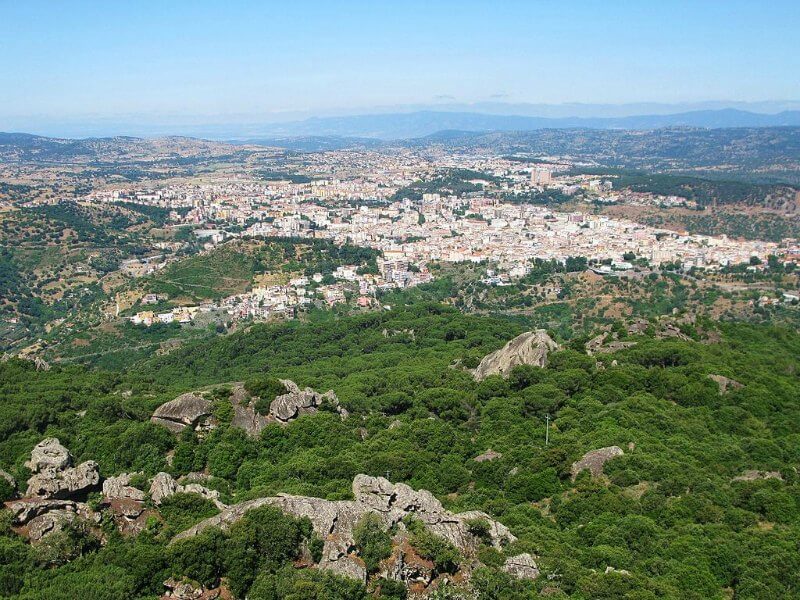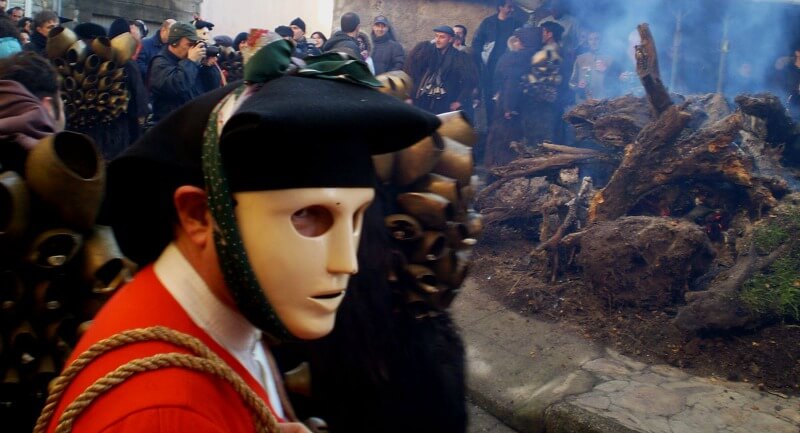I’m glad I ignored the guidebooks that dismissed Mamoiada as “undistinguished”, noteworthy only for its carnival. I was in need of a mountain “fix”, and the view on the road from Nuoro to Mamoiada alone is worth the trip.

The stalwart granite peaks of Sardinia’s Barbagia region shield and corral the dainty, pastel-hued villages huddled at their feet, tricking them into believing that there’s no reason to leave, nothing else to see but this shaggy quilt of green scrub, leafy vines and gold pastures stitched together by low stone walls. Here and there the pattern explodes into clusters of scampering sheep and frothy pink peonies.
It’s not just the scenery that attracts me, but also an ancient presence still felt in Mamoiada. When interviewed about his sculptures in San Sperate, renowned Sardinian artist Pino Sciola once said that answering all questions about the stones would kill the magic that Nature had created. There is little danger of stripping Mamoiada of its magic because its origins, layered like the surrounding sedimentary hills, are not easily explained.

Take the famous Carnival, dating back to a point buried by time. The event takes place on January 17, the feast day of Saint Antonio, a Prometheus-like figure said to have stolen fire from Hell as a gift for humans.
On this occasion, certain villagers become Mamuthones, dark figures transformed by distorted masks and rough overcoats, burdened by rows of ponderous cowbells on their backs. The Mamuthones thump the ground with synchronized, ritualistic steps. They are surrounded by red-coated Issohadores who wield lassos that occasionally catch female spectators, suggesting a fertility ritual.
Other scholars have speculated that the grim Mamuthones represent captives, as the country was invaded by waves of people including Carthaginians, Romans and Saracens, all of whom left traces of their presence in Sardinia’s architecture and cuisine. Still others say the Mamuthones represent animals, integral to the survival of pastoral people. The stomping is also thought to awaken the earth and prepare it for rebirth in spring. This interpretation provokes a frisson of recognition, a recollection of a Mohawk rain dance back home in Canada, a faraway culture also rooted in nature.
Similar rites were practiced in nearby regions, and variations of the costumes are displayed at the Museo delle Maschere Mediterranee. The costumes from surrounding regions and countries tend to be more flamboyant, but the Sardinian masks, like many Sardinians themselves, are more subtly intense. Surrounded by fearsome mannequins, I become so absorbed in an exquisitely detailed wooden deer mask that I’m startled by the arrival of ordinary-looking visitors. The guide suggests if I like what I see, there are workshops nearby.
I’m drawn to Ruggero Mameli’s shop because he leaves the wood grain exposed on some masks rather than paint them black. A sign in his shop window solemnly declares that should you have a mask “emergency,” the artist can be found in his workshop.
Laura, the proprietor of my B&B, walks me to a plateau on the outskirts of town, where we slip through another portal in time. There, hidden among the hills girdling Mamoiada, dozens of burial chambers dating back to around 3000 B.C. have been carved into the rocks. The areas surrounding Sardinia’s nuraghi (ancient towers) and crypts is said to give off magnetic waves, likely due to the presence of metallic minerals. The ancients may have believed, as Aristotle did, that they had curative powers and were beneficial to those who had passed on.
Subsequent cultures named the crypts Domus de Janus or houses of fairies. The confusion is understandable, given that the tombs were made to resemble the homes of the living. Moreover, fake doors were carved into some walls, suggesting an entrance to the next life. The horns of a bull, representing the divinity Taurus, also appear on some walls, and I am touched to discover that this may have been a means of summoning protection for the sheep of the deceased.

I make a mental note to visit the interactive MATer Museo dell’archeologia for enlightenment about Sa Perda Pinta, the standing stone looming in the fading light surrounding the plateau. It bears the cup and ring marks found on other megaliths throughout the world, a remarkable cultural bond, considering the absence of long-distance communications technology at that time. Were the patterns a talisman? Maps of the sky? Archaeologists are still pondering these questions.
Laura explains that the whole village gathers here for the feast of Saint Antonio. Christian and pagan traditions converge on the plateau, where a bonfire is built. Each household contributes a different dish to the meal. ”We like to be together,” concludes Laura.
The nurturing impulse extends to the natural world, as evidenced by the town’s carefully tended jewel box gardens and vineyards. The Cantina Giuseppe Sedilesu, for example, favours biodynamic wine and traditional cultivation methods, such as hoeing by hand and ploughing with oxen. The region is known for Cannonau, the polyphenol-rich red wine said to contribute to Sardinian longevity.
On the way back into town, we pass murals illustrating mamuthones and slices of pastoral life. Mamoiada is one of several “painted villages” in this region. Given the themes, I ask Laura if the public artwork is motivated by nostalgia or by a desire to attract and educate tourists.
“Sfogare”, she replies “and pride in local folklore. Sfogre is a strong word that can signify “to vent”, “to let oneself go” or “to give full expression to one’s feelings.”

As we consider dinner, I mention allergies that may limit our options, but the restaurants here are accustomed to gluten intolerance. We go to Mommo’s Pizzeria, easy to miss because of its unassuming exterior. Laura suggests that I drizzle a local olive oil over the thin, wood-fired crust. The light, fragrant oil releases the rich aroma of the tomato sauce and I experience sfogare. “Bravo Mommo,” is all I can articulate. The hills must really be magnetic because I’m already daydreaming about my next visit to Barbagia.
P.S. To the little white dog who waited for my bus with me in the darkness before dawn, you are a credit to your community.
Guest Contribution by Linda Handiak. Linda is a teacher and translator by day, goat herder and mason during summer break.
SARDINIA MAMOIADA RESOURCES
To plan your trip to Sardinia, click here first.
Getting there
Arst buses serve this region from Nuoro.
Accommodation
B&B Sa Nuche, Piazza San Sebastiano 5 edificio – run by a considerate host who maintains an immaculate house. Tel +39 339 685 7352
Immersive Experiences
Learn to make a mask or spend a day with shepherds with Meskes Turismo
Food and drink
Pizzeria da Mommo, Corso Vittorio Emanuele III, 101 Tel: +3907456444
Cantina Giuseppe Sedilesu, Via Vittorio Emanuele II, 64 Tel: +39078456791

